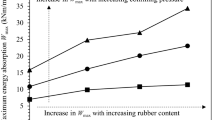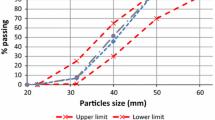Abstract
The rubber bands used in the track chains of excavators, known as track pin rubber bands, frequently experience failures due to factors such as their heavyweight, fast speed, sharp objects on off-road paths, shocks, vibrations, accumulated heat (generated during operation), and track tension. To identify the main cause of these failures, we conducted a failure analysis by evaluating their chemical compositions, morphological, mechanical, and thermal properties. For this study, four different types of failed rubber bands, designated as RB1, RB2, RB3, and RB4, were collected from the track pins of four distinct excavator track chains. None of the selected rubber bands passed the 1000 km running trial. RB1 failed after covering 650 km, RB2 failed after 250 km, RB3 after 400 km, and RB4 after 800 km. Both mechanical and thermal properties are dependent on the chemical formulations of the rubber bands, and all the failed rubber bands exhibited poor chemical formulations. RB1 showed a Schallamach wave on the outer used surface, indicating significant plastic deformation before fracture. In contrast, the other failed rubber bands (RB2, RB3, and RB4) displayed severe mechanical degradation with surface defects such as deep grooves, catering or pitting, micro-cracks, and scars. Thermogravimetric analysis further supported the cause of failure, revealing higher total mass loss and lower residue mass percentages.








Similar content being viewed by others
References
B. Li, V.R.L.P. Bahadursha, M.S. Hoo Fatt, Predicting failure in rubber membranes: An experimental-numerical approach. Eng. Fail. Anal. 90, 404–424 (2018)
L.H. Zhao, X.B. Wei, X.G. Li, The analysis on the tribological properties of CR/EPDM blends with chrome-plated steel under dry sliding. Adv. Mater. Res. 774–776, 99–102 (2013)
G. Bódai, T.J. Goda, Friction force measurement at windscreen wiper/glass contact. Tribol. Lett. 45(3), 515–523 (2012)
L.I. Farfán-Cabrera et al., Experimental method for wear assessment of sealing elastomers. Polym. Testing. 53, 116–121 (2016)
B. Lorenz, et al. Rubber friction on road surfaces: Experiment and theory for low sliding speeds. J. Chem. Phys. 142(19) (2015).
M. Khafidh et al., Understanding the occurrence of a wavy wear track on elastomeric materials. Wear. 412–413, 23–29 (2018)
P.R. Fry, Loads and stresses—the real cause of failures in surface mining machinery. Pract. Fail. Anal. 3(2), 7–14 (2003)
S.M. Bošnjak et al., ‘Designing-in’ failures and redesign of bucket wheel excavator undercarriage. Eng. Fail. Anal. 35, 95–103 (2013)
S.M. Bošnjak et al., Failure investigation of the bucket wheel excavator crawler chain link. Eng. Fail. Anal. 35, 462–469 (2013)
S. Bošnjak et al., Cracks, repair and reconstruction of bucket wheel excavator slewing platform. Eng. Fail. Anal. 16(5), 1631–1642 (2009)
S. Bošnjak et al., Failure analysis of the end eye connection of the bucket wheel excavator portal tie-rod support. Eng. Fail. Anal. 16(3), 740–750 (2009)
S.M. Bošnjak et al., Bucket wheel excavator: Integrity assessment of the bucket wheel boom tie-rod welded joint. Eng. Fail. Anal. 18(1), 212–222 (2011)
S. Bošnjak et al., Failure analysis and redesign of the bucket wheel excavator two-wheel bogie. Eng. Fail. Anal. 17(2), 473–485 (2010)
M. Savković et al., Analysis of the drive shaft fracture of the bucket wheel excavator. Eng. Fail. Anal. 20, 105–117 (2012)
S.M. Bošnjak et al., Failure of the bucket wheel excavator buckets. Eng. Fail. Anal. 84, 247–261 (2018)
S.M. Bošnjak et al., Bucket chain excavator: Failure analysis and redesign of the counterweight boom supporting truss columns. Eng. Fail. Anal. 32, 322–333 (2013)
Y. Li et al., Failure analysis of bolts on fatigue test bench for excavator stick. Eng. Fail. Anal. 118, 104863 (2020)
Z.S. Liu et al., Prediction of noise inside tracked vehicles. Appl. Acoust. 67(1), 74–91 (2006)
W. Balasooriya et al., The effect of the surface area of carbon black grades on HNBR in harsh environments. Polym. 11(1), 61 (2019)
P. Wang, X. Rui, H. Yu, Study on dynamic track tension control for high-speed tracked vehicles. Mech. Syst. Signal Process. 132, 277–292 (2019)
P. Thavamani, A.K. Bhowmick, D. Khastgir, Effect of ageing on strength and wear of tank track pad compounds. Wear. 170(1), 25–32 (1993)
P. Thavamani, A.K. Bhowmick, Wear of tank track pad rubber vulcanizates by various rocks. Rubber Chem. Technol. 65(1), 31–45 (1992)
C. Pergantis, Thermographic field-inspection study on M1 main battle tank track systems. Aerospace Sensing. 1682, SPIE (1992)
W. Kim et al., Fatigue crack growth behavior of NR and HNBR based vulcanizates with potential application to track pad for heavy weight vehicles. Macromol. Res. 11(2), 73–79 (2003)
A. Dhir, S. Sankar, Assessment of tracked vehicle suspension system using a validated computer simulation model. J. Terrramech. 32(3), 127–149 (1995)
P. Thavamani, D. Khastgir, A.K. Bhowmick, Microscopic studies on the mechanisms of wear of NR, SBR and HNBR vulcanizates under different conditions. J. Mater. Sci. 28(23), 6318–6322 (1993)
L. Karásek, M. Sumita, Characterization of dispersion state of filler and polymer-filler interactions in rubber-carbon black composites. J. Mater. Sci. 31(2), 281–289 (1996)
A. Grincova, M. Andrejiova, D. Marasova, Failure analysis of the impact resistance of protective rubber panels. Eng. Fail. Anal. 139, 106481 (2022)
M.G. Maya et al., Development of a flexible and conductive elastomeric composite based on chloroprene rubber. Polym. Testing. 65, 256–263 (2018)
Z. Xu et al., Graphene oxide-supported zinc oxide nanoparticles for chloroprene rubber with improved crosslinking network and mechanical properties. Compos. A Appl. Sci. Manuf. 124, 105492 (2019)
Author information
Authors and Affiliations
Corresponding author
Additional information
Publisher's Note
Springer Nature remains neutral with regard to jurisdictional claims in published maps and institutional affiliations.
Rights and permissions
Springer Nature or its licensor (e.g. a society or other partner) holds exclusive rights to this article under a publishing agreement with the author(s) or other rightsholder(s); author self-archiving of the accepted manuscript version of this article is solely governed by the terms of such publishing agreement and applicable law.
About this article
Cite this article
Hafeez, M.A., Farooq, A. & Deen, K.M. Analyzing the Premature Failure of Rubber Bands in Excavator Track Chains. J Fail. Anal. and Preven. 24, 179–189 (2024). https://doi.org/10.1007/s11668-023-01830-5
Received:
Accepted:
Published:
Issue Date:
DOI: https://doi.org/10.1007/s11668-023-01830-5




